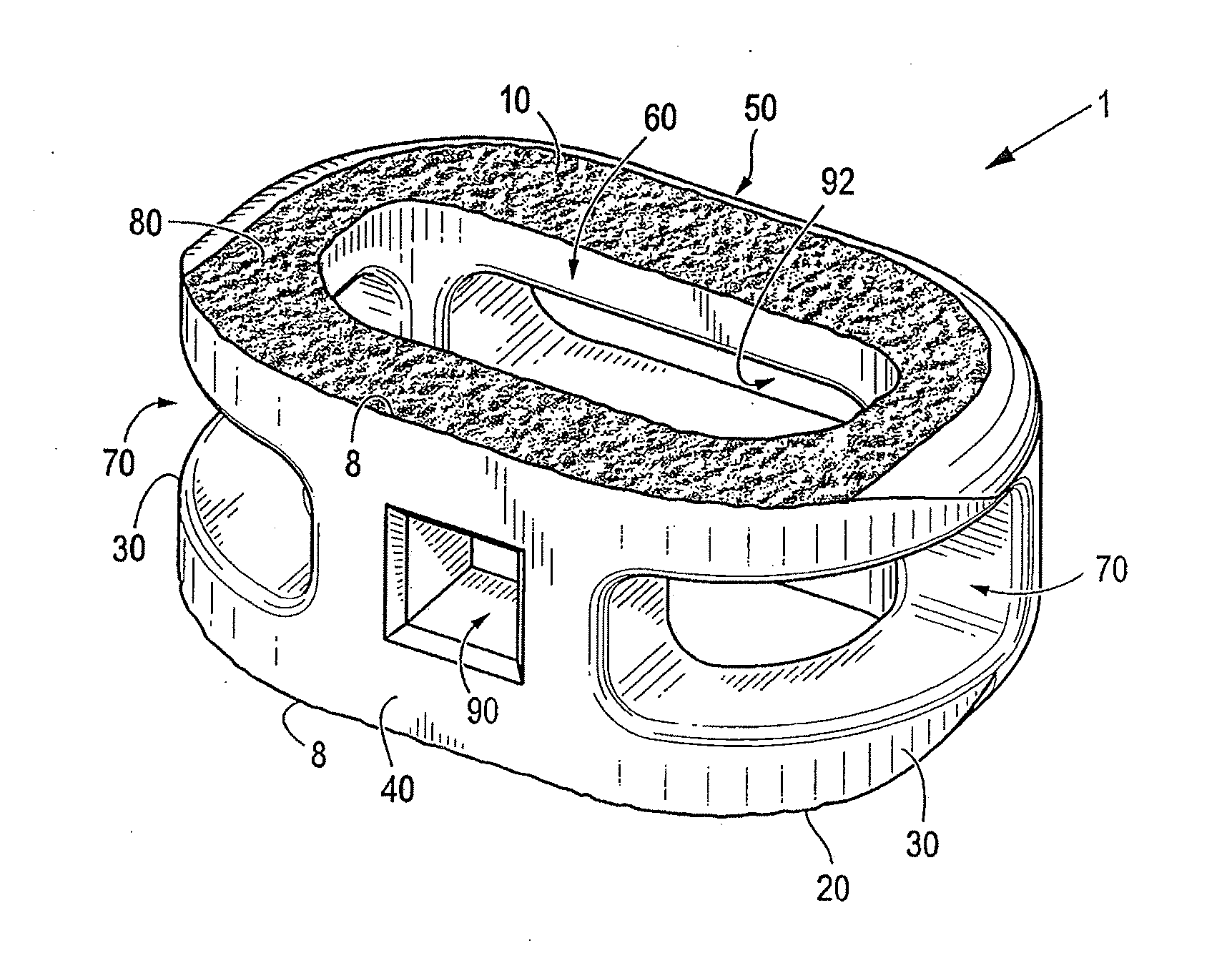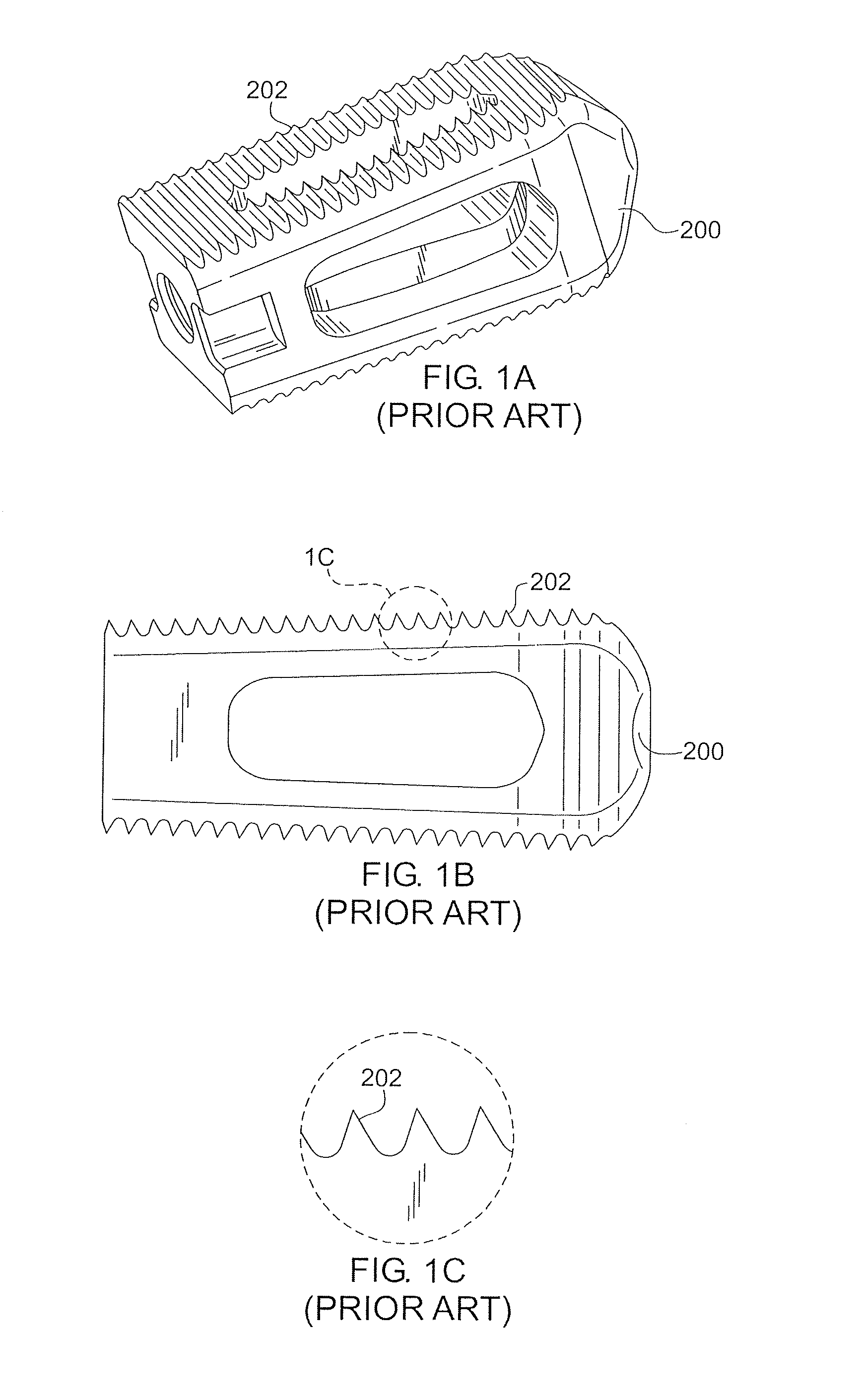Over time, the discs may become diseased or infected, may develop deformities such as
tears or cracks, or may simply lose
structural integrity (e.g., the discs may bulge or flatten).
Impaired discs can affect the anatomical functions of the vertebrae, due to the
resultant lack of proper biomechanical support, and are often associated with chronic
back pain.
This location is not the preferable seating position for an implant
system, however, because only a relatively small portion of the
vertebral endplate is contacted by these cylindrical implants.
The seating of these threaded cylindrical implants may also compromise biomechanical integrity by reducing the area in which to distribute mechanical forces, thus increasing the apparent stress experienced by both the implant and vertebrae.
These size-limited implant systems may also poorly accommodate related
instrumentation such as drivers, reamers, distractors, and the like.
For example, these implant systems may lack sufficient
structural integrity to withstand repeated
impact and may fracture during implantation.
Still further, other traditional non-allograft ring-shaped cage systems may be size-limited due to varied and complex supplemental implant
instrumentation which may obstruct the
disc space while requiring greater
exposure of the operating space.
These supplemental implant
instrumentation systems also generally increase the instrument load upon the surgeon.
During a surgical procedure in the spine if this sealed vessel has been perforated it is believed that the semi-
rigid structure opposing biologic loading is compromised and cannot heal and return to the
proper function which it performs.
It is also believed that if the high-density bone is removed exposing low-density
cancellous bone and the
implanted device does not have a stress-sharing surface of sufficient size to transfer loading it will allow the
cancellous bone to be abraded further compromising the return to correct position.
Damage to the endplate surfaces over the long term will continue the progression of the condition regardless of the implantation of an
intervertebral fusion implant.
Traditional interbody spinal implants generally do not seat properly on the preferred structural bone located near the apophyseal rim of the
vertebral body, which is primarily composed of preferred dense
subchondral bone.
Such challenges include: (1) end-plate preparation; (2) implant difficulty; (3) materials of construction; (4) implant expulsion; (5) implant
subsidence; (6) insufficient room for bone graft; (7)
stress shielding; (8) lack of implant incorporation with
vertebral bone; (9) limitations on radiographic
visualization; and (10) cost of manufacture and inventory.
In the process of aggressive end-plate removal, however, the end-plates are typically destroyed.
Such destruction means that the load-bearing implant is pressed against soft cancellous bone and the implant tends to subside.
The end-plates are concave; hence, if a flat implant is used, the implant is not very stable.
Even if a convex implant is used, it is very difficult to match the implant geometry with the end-plate geometry, as the end-plate geometry varies from patient-to-patient and on the extent of
disease.
This method also violates the structure.
Traditional anterior
spinal fusion devices can also be difficult to implant.
These teeth can bind to the surrounding
soft tissue during implantation, creating surgical challenges.
If there is a restriction on the
exposure size, then the
maximum size of the implant available for use is correspondingly limited.
Still further, secondary instrumentation may sometimes over-distract the annulus, reducing the ability of the annulus to compress a relatively undersized implant.
A typical traditional implant has design features to accommodate only one or two of these approaches in a single implant, restricting intra-operative flexibility.
Materials such as PEEK or
cadaver bone do not have the structural strength to withstand
impact loads required during implantation and may fracture during implantation.
Cadaver bone carries with it the risk of
disease transmission and raises shelf-life and storage issues.
In addition, there is a limited supply of donor bone and, even when available,
cadaver bone inherently offers inconsistent properties due to its variability.
Both options can create localized stress risers in the end-plates, increasing the chances of
subsidence.
The challenge of preventing implant expulsion is especially acute for PEEK implants, because the material texture of PEEK is very smooth and “slippery.”
Subsidence of the implant is a complex issue and has been attributed to many factors.
These design restrictions do not leave much room for filling the bone graft material into
cortical bone implants.
Typically, however, the stiffness of the
implant material is much greater than the adjacent
vertebral bone and takes up a majority of the mechanical loads, “shielding” the bone graft material from becoming mechanically loaded.
In most cases, the typical fusion implant is not able to incorporate with the
vertebral bone, even years after implantation.
Such inability persists despite the use of a variety of different materials to construct the implants.
The application of such bio-active materials has been limited, however, for several reasons, including
biocompatibility, structural strength, and lack of regulatory approval.
Hence it is difficult to assess fusion, if it is to take place.
This requirement means that the manufacturer needs to carry a significant amount of inventory of implants.
Because there are so many different sizes of implants, there are setup costs involved in the manufacture of each different size.
The result is increased implant costs, which the manufacturers pass along to the end users by charging high prices for
spinal fusion implants.
 Login to View More
Login to View More 


